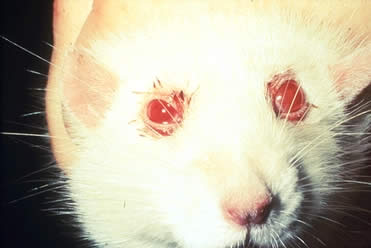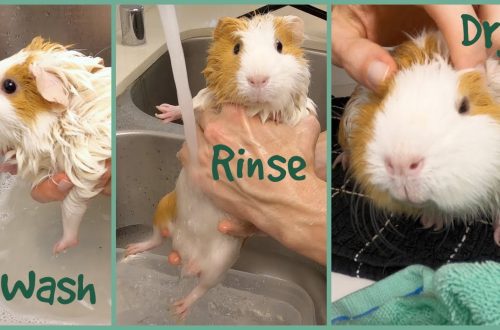
Rainbow fish: maintenance rules, external characteristics, nutrition and reproduction
Neon iris (a member of the Melanoteniev family) is a popular aquarium fish. It is the most common and smallest in its family. Melanothenia neon has been known since 1922, but only in the 90s it was brought to Europe.
With small changes in light while swimming, the scales of the fish flash in spectacular blue and blue hues with a neon glow. This feature has captivated aquarists around the world.
In the natural environment, neon irises are found in the Mamberamo River, which flows through the territory of Western Papua, small streams and rivers of Western New Guinea. In these reservoirs, clear water, fast current and dense vegetation.
Contents
Content Rules
In wildlife conditions, the iris can withstand a temperature range of 5-35 ° C. Such fluctuations are undesirable for fish kept in aquariums, as they negatively affect health and appearance. Melanothenia neon lead a dynamic lifestyle, despite their small body size they need a spacious aquarium with enough space for swimming. There are average water indicators for a comfortable stay of iris fish.
Basic water requirements:
- it must be settled, since very hard can lead to poor health and even death;
- temperature 20–28 °C, neutral acidity pH 6–8, dH 4–9;
- the volume of liquid is not less than 50 liters;
- a weekly ¼ water change is recommended.
The parameters of the aquarium and the interior must meet the following requirements:
- you need a spacious and long aquarium (at least 40–45 cm). fish like to swim horizontally, not vertically. Length is preferred over height;
- balance: powerful aeration system, good filtration, full lighting (sunlight);
- it is desirable to arrange a light flow;
- against the background of the coloring of neon rainbows, dark soil will look especially advantageous;
- snags, large stones, artificial grottoes – perfectly complement the water interior;
- there are no special requirements for the choice of aquarium flora. Melanothenia feel great among a large number of plants;
- you need to leave space for free swimming.
Safety measures
It is very important that the ground and decorations do not have sharp edges. Melanothenia can get hurt because they swim fast, jump high out of the water during active games. Given this, the aquarium should be covered with a lid.
The ratio of the inhabitants of the aquarium and compatibility with neighbors
Iris prefer to live in small flocks up to 10 fish, with a predominance of females or an equal sex ratio. When fish are kept only for beauty, males are preferable, as they are brighter and larger. If breeding is planned, then a larger number of females in the pack is preferable.
The neon iris is peaceful, it feels good in a common aquarium with other species that are similar in character and size. The best neighbors will be medium-sized, peaceful and calm fish. Suitable company:
- scalars;
- discus;
- somiki;
- barbs;
- gourami;
- cockerels.
May contain shrimp. Although the iris do not offend the neighbors, it is better to refrain from very small species in order to prevent eating.
Food
In nature, animals and plants are eaten. At home, irises are unpretentious, eat all types of food: live, dry and frozen. A food that sinks slowly is desirable. The flock prefers the upper or middle layers of water and hardly eats from the bottom. It is often necessary to clean the ground or bring in, for example, speckled catfish that pick up leftover food.
The diet must be balanced. It is advisable to give enough to eat completely. The predominance of dry food is not allowed, as this is fraught with poor health. When the fish are very hungry or there are no plant foods in the diet, then can eat algae on glass and stones, as well as delicate aquatic plants.
With pleasure they eat small bloodworms, tubifex, brine shrimp, crustaceans. From plant foods – scalded lettuce, slices of cucumber, zucchini or food with spirulina.
External characteristics
For its small size, Melanothenia neon is called dwarf. In an aquarium (under good conditions) lives for about 5 years. In nature, it grows up to 8 cm, in aquariums no more than 6 cm.
The body is elongated and flattened laterally. The females have a fuller abdomen, while the males have a flattened one. The body color is pinkish grey. The females are more silvery. Small flattened head and large eyes. The dorsal, anal, and caudal fins are yellow-orange in females and reddish in males. There is a high hump on the back, a keel is located on the chest. Sexually mature males are taller, larger and brighter than females.
With seeming simplicity, the neon iris fish is very attractive. When hit by light or different angles, her scales explode into bright blue-blue neon hues, while darker edging further enhances the radiant effect. In the morning, the color is the brightest, the colors are maximally saturated, with a neon glow.
Reproduction and conditions in the spawning ground
The ability to reproduce (puberty) appears in iris at 8–10 months. The largest and brightest male is suitable for spawning, as well as a well-fed female. Before breeding fish need a varied and plentiful feed, preferably animal feed with the addition of vegetable. When the female is ready to spawn, the male mates with her and fertilizes. After mating games, the female lays eggs in dense foliage. With each spawning, the amount of caviar increases. Producers are removed if the amount of caviar decreases or signs of exhaustion appear.
A separate small aquarium is suitable for breeding, with a water level not higher than 35 cm, with a volume of about 30 liters – a spawning ground. Temperature 26–28 °C, pH 7. Slight current is provided, small-leaved vegetation should be densely planted. Spawning is stimulated by a slight increase in temperature, frequent water changes, a rich diet (thus simulating the rainy season).
Spawning usually takes place in the morning. Active spawning lasts up to three days, then decreases. Productivity depends on the state of health and size of the individual. The female spawns in small portions, up to 500-600 eggs in total on a sticky thread that settles on the leaves of plants. Better right away move the caviar to a separate container (with the same water parameters), in order to avoid eating eggs by parents. After spawning, the parents are returned to a large aquarium. The dead white caviar is removed.
Offspring
The incubation period depends on the conditions in the spawning ground and lasts an average of 6-10 days. Small gray larvae begin to swim and eat on the 5th day. Will serve as starting food ciliates and “living dust”, later microworms, egg yolk, brine shrimp, cut enchitrei will do. The fry grow slowly and survive only in clean water conditions. Neon colors appear in them only after a month and a half.
What should I look for?
The irises are prone to bacterial infections. In case of diseases need to quarantine, for example, remove fungal plaque from the head of a fish.
Long transportation, bright flashes when taking pictures can lead to stress, then the fish will turn silver-gray. Unfavorable conditions should be avoided. Fresh water with stable performance, peace, good nutrition – a guarantee that the neon iris will not fade and continue to sparkle with bright colors.





